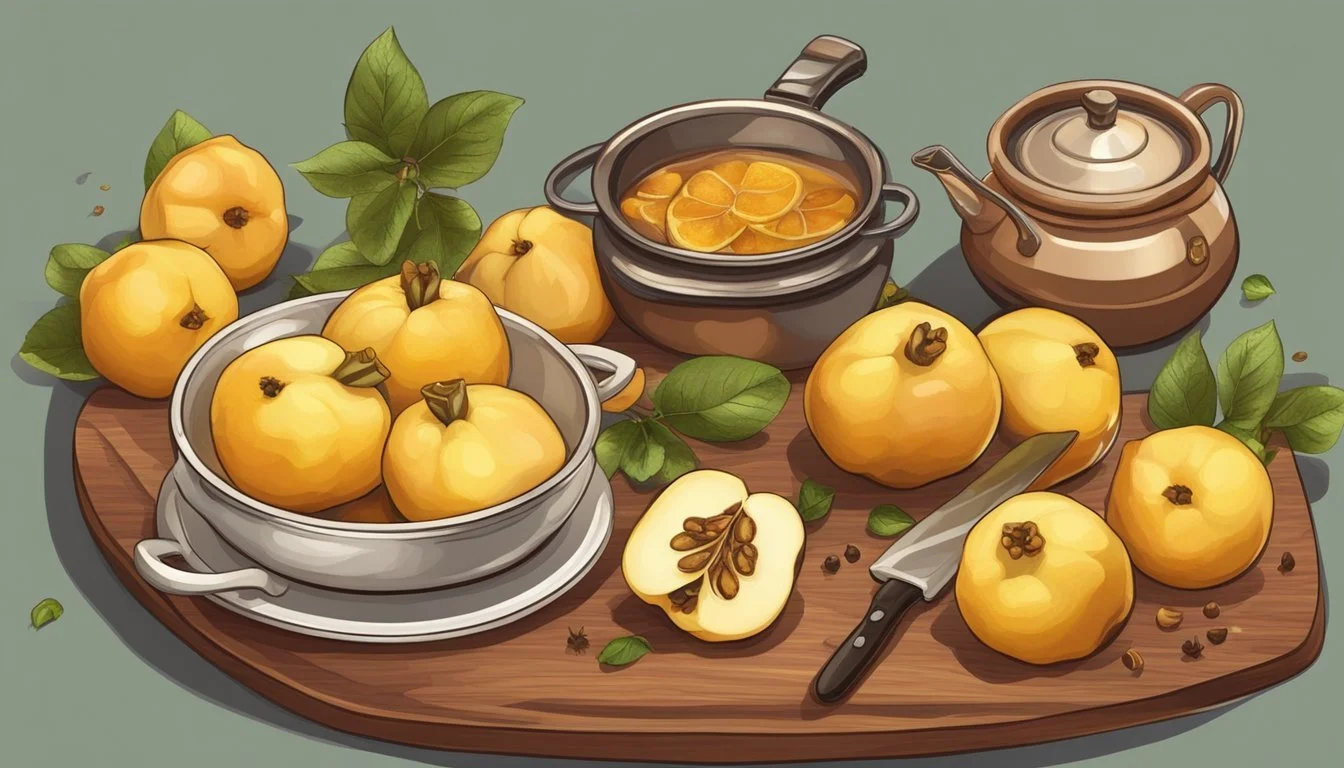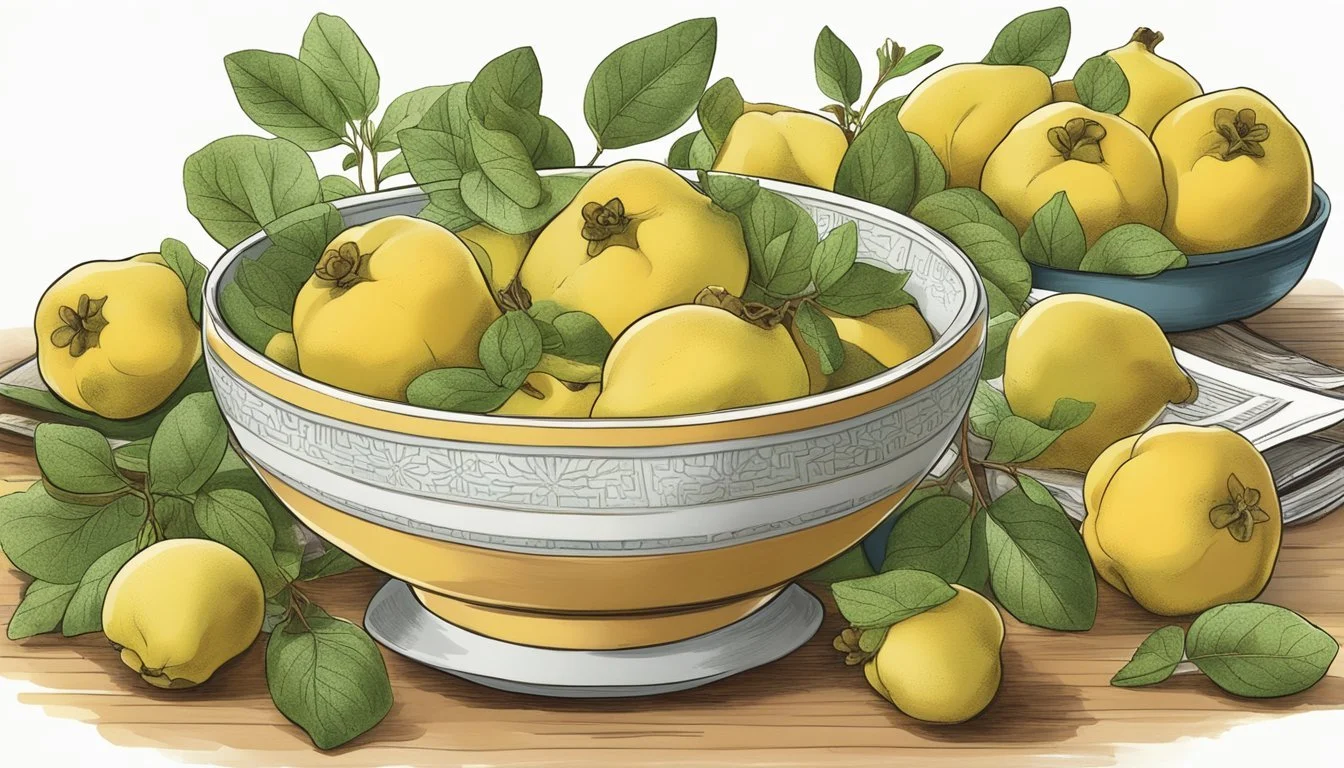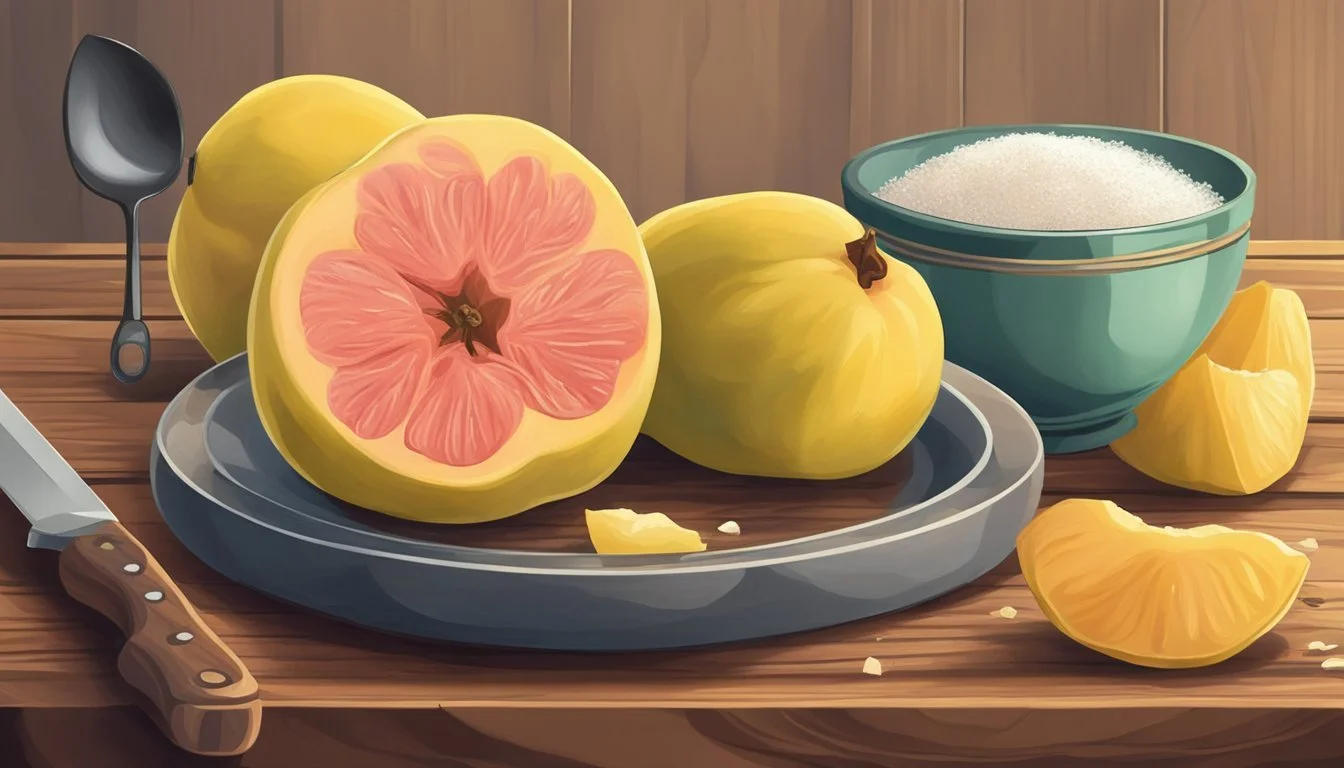How to Cook with Quince
Mastering Fragrant and Sweet Culinary Delights
Quince, a relative to apples and pears, offers a unique taste and fragrance to culinary creations. This underappreciated fruit transforms from a hard and tart specimen to a soft, sweet delight when cooked, revealing its potential in a variety of dishes. To achieve the best results, it's important to cook the quince thoroughly, a process that turns its flesh pink and enhances its naturally aromatic qualities. The fruit is versatile; it can be poached, roasted, or stewed, which allows it to fit into both sweet and savory contexts.
Preparing quince requires patience as its flesh is firm, but the rewards are worth the effort. Cooking quince often involves a gentle, lengthy simmer or bake until it becomes tender. Common methods include poaching in simple syrup, perhaps with the addition of flavorful spices such as vanilla, star anise, or cinnamon to complement its fragrant profile. This process not only softens the fruit but also infuses it with the chosen flavors.
Incorporating quince into recipes opens a gateway to an array of dishes. Its firm texture holds up well in stews and can be a robust addition to meat-based plates, adding a subtle sweet contrast. Alternatively, the fruit's sweetened and softened version is a perfect component for desserts like tarts and jellies. As quince is not typically eaten raw due to its astringency, the act of cooking is essential to unveil its sweet potential and make it palatable.
History and Significance of Quince
Quince holds a notable place in both cultural and historical contexts. Its relevance extends from ancient traditions to medieval culinary practices, embodying a rich legacy.
Cultural Significance
The quince is more than just a fruit; it is imbued with deep cultural meaning. It is often associated with the goddess Aphrodite, symbolizing love and fertility. This connection has led to the fruit being featured in wedding customs across the world, emblematic of a sweet life for newlywed couples.
Historical Uses
In historical terms, the quince occupies a significant place within the rose family and has been cultivated since ancient times. Medieval recipes frequently included quince, which was prized for its perfume and sweetness. The fruit was traditionally used in marmalades and jams, its pectin-rich nature facilitating the gelling process. Quince would also be cooked slowly to enhance its natural flavors, commonly used in sweet and savory dishes alike.
Selecting and Preparing Quince
When embarking on the culinary exploration of quince, one must first master the art of selecting the best specimens and understand the fundamentals of preparation. This section provides guidance on choosing quince and how to effectively peel and core this cousin of the pear and apple.
How to Choose the Best Quince
One should seek out quince with a vivid yellow skin, indicating ripeness and readiness for cooking. The fruit should be firm to the touch with no blemishes or soft spots. The aroma is also a powerful indicator; a good quince emits a strong, pleasant fragrance.
Preparation Basics: Peeling and Coring
Quince requires preparation similar to its relatives, the pear and apple, before cooking. Though the flesh is firmer and more challenging to work with. Here's a concise guide to peeling and coring a quince:
Peeling: Start by washing the quince thoroughly to remove any fuzz. Use a sturdy peeler to peel the tough skin, revealing the pale flesh beneath.
Coring: Slice the quince in half from stem to bottom. Use a sharp knife or a corer to remove the core, which is harder than that of apples or pears. Take care to cut out the entire core, as it is not palatable.
It is imperative to note that peeled and cored quince will oxidize quickly. To prevent browning, one may submerge the prepared quince in water with a squeeze of lemon juice.
Fundamental Cooking Techniques
When cooking with quince, one should revel in the transformation that occurs when the fruit's tough flesh becomes tender. Techniques such as poaching and baking are essential in refining the flavor and texture of this fragrant fruit.
Poaching Quince
To poach quince, one begins by peeling and cutting the fruit into halves or quarters, then carefully removing the core. It's advisable to soak the cut pieces in water to prevent discoloration. A poaching liquid is prepared in a saucepan by mixing water, sugar, and sometimes honey, which is brought to just a boil. The quince is then added, and the mixture is reduced to a simmer. For the fruit to become suitably tender, it typically needs to be simmered for 40 to 50 minutes, depending on the size of the pieces. To ensure even cooking and to prevent liquid from evaporating too quickly, a parchment lid or a partially placed lid over the pot is recommended. Once the fruit is tender and the liquid has turned into a lightly colored syrup, the poached quince is ready.
Baking With Quince
Baking transforms quince into a delectable dish using the dry heat of an oven. One should preheat the oven - the temperature often ranges from 350°F to 375°F (175°C to 190°C). While the fruit can be baked whole, it is typically peeled, cored, and cut into large chunks for even cooking. Quinces are arranged in a baking dish sometimes with added ingredients for flavor, such as spices or other fruits. Covering the dish with a lid or foil is essential to keep in moisture. A bake time can vary; the quince is cooked when it can be easily pierced with a fork, generally after about one hour. Baking not only softens quince but also deepens its natural flavors, leaving it with a buttery texture that is both sweet and aromatic.
Quince in Sweet Creations
Quince transforms into a fragrant and sweet delight when cooked, making it a superb addition to various desserts and baked goods. Its natural pectin content ensures it enhances textures in jams and jellies while its floral notes bring a unique flavor profile to traditional sweets.
Quince Desserts
Cooked quince can be the highlight of many traditional desserts.
Poached Quince: Can be served with cream or ice cream, creating a pairing of soft fruit texture with rich dairy.
Quince Jelly: A clear, rose-hued jelly that can be spread on toast or paired with meats and cheeses.
Quince Pudding: An aromatic dessert featuring spiced, stewed quince baked into a warm, comforting pudding.
Quince Pastries and Pies
Quince lends its sweet-tart flavor perfectly to baked goods.
Quince Tart: Thin slices of poached quince layered atop buttery pastry, often sweetened with honey or maple syrup.
Quince and Apple Pie: Combining quince with apples offsets the sweetness and adds complexity.
Quince Turnovers: Flaky pastry pockets filled with sweetened quince jam, ideal for handheld treats.
Sweet Sauces and Syrups
Enhance the flavor of various desserts with quince-infused sauces and syrups.
Quince Syrup: The poaching liquid from quinces reduced down to a thick syrup, excellent for drizzling over pancakes or waffles.
Quince Sauce: Made by blending cooked quince into a smooth sauce, sometimes sweetened with sugar or simple syrup, and can be used as a topping for desserts like puddings or cheesecakes.
Savory Quince Delights
Quince transforms savory dishes with its fragrant aroma and subtly sweet notes. When cooked, quince softens and can impart depth to a variety of meat and vegetable preparations.
Adding Quince to Meat Dishes
In meat dishes, quince pairs exceptionally well with pork, offering a balancing sweetness that complements the rich, savory flavors. A classic method is to incorporate quince into stews. As the stew simmers, the quince breaks down, contributing to both the texture and the fragrant bouquet of the dish.
Pork Stew with Quince: Enhance a hearty pork stew by adding chunks of quince during the last hour of cooking. This allows the quince to become tender without disintegrating, while its pectin thickens the stew, resulting in a more luxurious texture.
Quince in Vegetable Side Dishes
Quince can also be a star in vegetable side dishes where its sweetness counterpoints earthy flavors.
Roasted Vegetables with Quince: Introduce slices of quince to a pan of root vegetables before roasting. The quince will caramelize and infuse the dish with a subtle, apple-like sweetness.
Quince-Spiced Carrots: For an aromatic side, add grated quince to carrots when sautéing. It not only uplifts the dish with a pleasant sweetness but also adds a moist, slightly grainy texture that contrasts with the tender carrots.
Preserving Quince
Preserving quince allows one to enjoy its distinctive fragrant and sweet flavor throughout the year. The fruit's high pectin content makes it ideal for creating jellies, jams, and pastes that can be refrigerated and savored for months.
Quince Jelly and Jam Making
Quince jam and jelly rely on the fruit's natural pectin for setting. One begins by cooking the quince pieces until they are tender. For jelly, the cooked quince is mashed and strained to produce a clear juice, to which sugar is then added. The mixture is boiled until it sets upon cooling. Jam making is similar, but the fruit is not strained, leaving bits of quince suspended in the preserve. Both preparations may include flavorings like vanilla or rosewater to enhance the quince's aroma.
Ingredients for Quince Jam:
Quince
Sugar
Water
Optional flavorings: vanilla, rosewater
Steps:
Cook quince until fork tender.
Mash the cooked quince (for jam).
Add sugar and boil the mixture.
Test for set before cooling.
Creating Quince Paste and Membrillo
Quince paste, also known as membrillo, is a thick, sweet confection commonly paired with cheese. The process involves cooking the fruit with sugar until it thickens considerably and takes on a deep, rosy color. This paste is then poured into molds and allowed to cool, forming a dense, jelly-like block that can be sliced. Properly made quince paste or membrillo can last for several months when refrigerated, making it a delightful addition to appetizer platters.
Ingredients for Quince Paste:
Quince
Sugar
Steps:
Peel and core the quince, then chop.
Cook with sugar until thick and rose-colored.
Pour into molds and cool.
Refrigerate to extend shelf life.
Quince Flavor Pairings
The unique taste of quince can be enhanced by combining it with various spices, herbs, and cheeses. A well-chosen pairing can elevate the aromatic profile of dishes using this fruit.
Spices and Herbs That Complement Quince
Spices:
Cinnamon: Its warm, sweet notes blend seamlessly with quince in both sweet and savory dishes.
Vanilla: It adds a creamy, floral essence that accentuates the quince's fragrance.
Ginger: Provides a spicy kick that contrasts the fruit's sweetness.
Herbs:
Cardamom: Has a citrusy-sweet flavor that pairs well with quince in compotes and desserts.
Rosemary: Its piney aroma complements the quince in savory applications like roasts.
Quince and Cheese Pairings
Blue Cheese: The strong, tangy flavors of blue cheese balance the sweet, floral notes of quince.
Aged Cheeses (What wine goes well with aged cheeses?): Harder cheeses like aged Gouda or Cheddar can stand up to quince's bold taste.
The union of quince with these select spices, herbs, and cheeses paves the way for culinary excellence, adding layers of complexity and taste to various dishes.
Innovative Uses of Quince
Quince's versatility extends beyond traditional recipes, finding its place in modern cuisine and mixed beverages with a unique twist that caters to contemporary tastes.
Quince in Modern Cuisine
In the arena of modern cuisine, chefs often embrace the distinctive qualities of quince, showcasing its potential beyond the expected. Quince puree serves as an innovative base for savory sauces and glazes, pairing exquisitely with proteins such as duck and pork. This use of quince brings a subtle sweetness and floral aroma to hearty dishes. Furthermore, quince's naturally high pectin content makes it an ideal candidate for crafting artisanal jellies and pastes that accompany cheeses, enhancing the flavors with its rosy, tangy notes.
Quince in Drinks and Cocktails
Quince lends itself beautifully to the creation of sophisticated cocktails. Its sweet and tangy profile harmonizes with a variety of spirits. A popular method involves crafting quince liqueur, which can be used as a base for mixed drinks or served as a standalone sipper. Additionally, bartenders may incorporate quince as a puree in cocktails to introduce a novel texture and deep flavor. The fruit's complexity elevates the drink experience, making quince a go-to for inventive mixology.
Health Benefits and Nutritional Information
Quince is a fruit that carries various health benefits due to its rich nutritional content. It is a good source of dietary fiber, which is essential for digestive health. The fiber content aids in satiety, helps to control blood sugar levels, and supports regular bowel movements.
In terms of vitamins and minerals, quince provides vitamin C and potassium. Vitamin C is crucial for the immune system, skin health, and the absorption of iron from plant-based foods. Potassium is key for maintaining normal blood pressure and proper heart function.
Nutritional Profile of Quince:
Calories: Low in calories, making it a weight management-friendly fruit.
Fiber: High in dietary fiber, beneficial for digestion and satiety.
Vitamin C: An antioxidant that supports the immune system.
Potassium: Helps to regulate blood pressure and heart health.
People seeking to incorporate quince into their diets can enjoy it raw or cooked. When opting for raw consumption, they should be mindful of its astringent taste, which becomes sweeter and more palatable upon cooking.
Quince has also been noted for its potential health benefits, which include anti-inflammatory properties. These properties may contribute to the overall well-being and management of inflammation-related health issues.
Serving Suggestion: To include quince in one's diet:
Peel and slice the fruit.
Simmer in water until tender to reduce astringency.
Pair with complementary flavors such as vanilla, cinnamon, or citrus zests for enhanced taste.
This versatile fruit can be transformed into jams, jellies, or used as an accompaniment to savory dishes, broadening its appeal and making it a favored ingredient for health-conscious individuals.
Quince Handling and Storage Tips
When dealing with quince, it's key to understand that this unique fruit requires a bit of care to maintain its quality. The skin of quince is covered with a fuzzy down which should be gently scrubbed off before use.
Storage: Quince should be kept in a cool, dry place if they are to be used within a short period. For longer storage, they are best kept in the refrigerator. Here is a quick guide to proper storage:
Countertop: Place quince in a single layer, away from sunlight, if planning to use within a week.
Refrigerator: Wrap quince loosely in a plastic bag to retain moisture and store them for up to a few weeks.
Preservation: The flesh of quince is dense and high in pectin, which lends itself well to being cooked down into jams, preserves, or jellies.
Whole Quince: When storing whole quince, check regularly for signs of over-ripeness or decay, which can spread to other fruits.
Preparation: Before cooking or consumption, quince should be washed and its dense flesh may require a large, sharp knife to cut through. After cutting, place quince pieces in water with a dash of lemon juice to prevent browning.
Following these guidelines ensures the quince you've selected will maintain its aromatic and flavorful qualities. Enjoy incorporating this fragrant fruit into both sweet and savory dishes.
Troubleshooting Common Quince Problems
When cooking with quince, chefs may encounter several common issues. Below are some of the challenges and solutions to help ensure successful quince preparations.
Rot
Quinces are susceptible to rot, particularly if they sit in storage for too long. To avoid this, always visually inspect quinces for soft spots or discoloration before purchase and use them relatively quickly. If only a small part is affected, it can be cut away, but a heavily rotted quince should be discarded to prevent it from ruining the dish.
Peeling
Peeling quinces can be challenging due to their hard flesh. To make the task easier, they should first be sliced off from the core and then the skin can be more easily removed from these smaller sections. A sharp vegetable peeler or a paring knife is most effective for peeling.
Tough Flesh
Quince is notoriously tough before cooking. To tenderize:
Poach the quince in a simmering liquid until it reaches the texture of a ripe pear.
The cooking time can vary, so it is recommended to start checking after 15 minutes.
Remember to flip the slices if poaching to ensure even cooking.
Final Tips
Problem Solution Quince too hard to cut Use a sharp chef's knife and stabilize the fruit by cutting a flat base. Discoloration after cutting Use lemon juice or acidulated water to prevent browning. Uneven cooking Cook quinces at a low temperature for a long period; this also enhances their natural fragrance.
By addressing these issues with the right techniques, cooking with quince can yield deliciously fragrant and sweet dishes.









